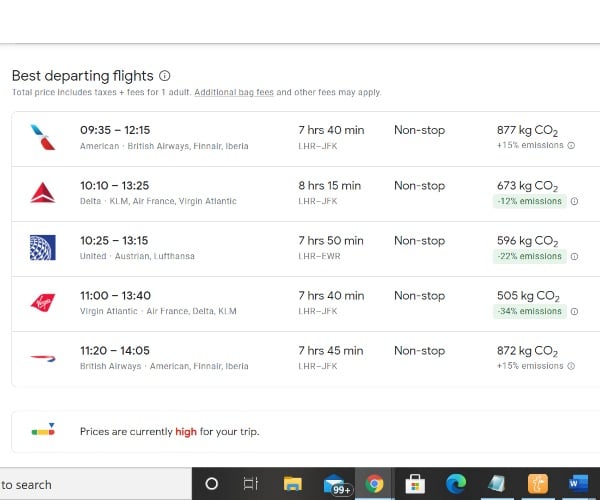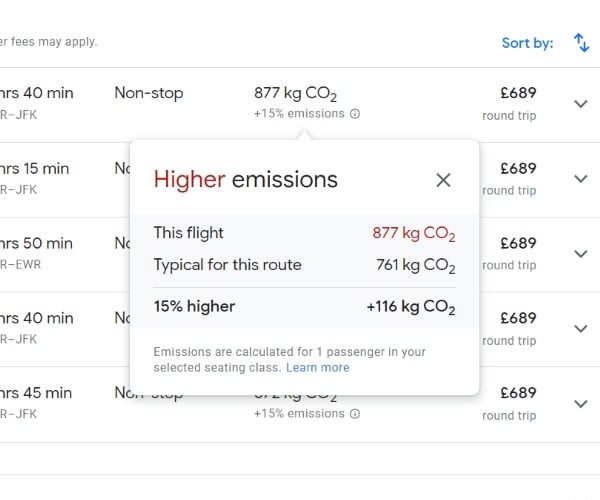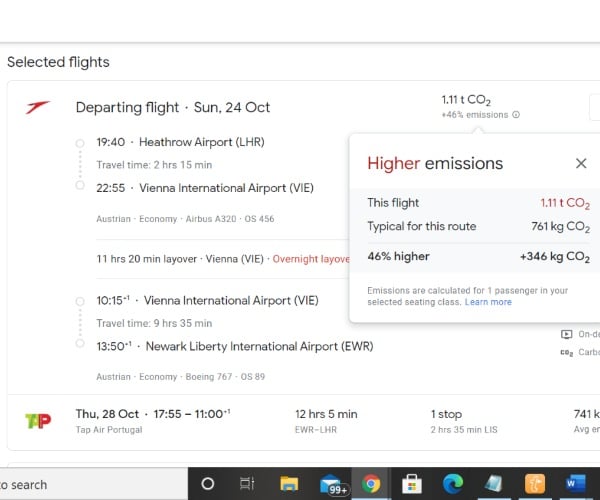Google Flights and carbon emissions
Have you seen the recent changes to the flight search function on Google Flights?
Google Flights, an online flight booking search service which facilitates the purchase of airline tickets through third-party suppliers, has now added the reporting of a flight’s carbon impact to its search results. This new change, whilst perhaps only just a first step in the fight towards making travellers more accountable for their carbon footprint, is nevertheless an important one.

 It clearly signposts the options with the least carbon emissions and, in so doing, highlights the often lower impact of direct flights. For instance, if you fly from London to New York with Austrian on our example search, you’ll notice it might be the cheapest option, but that it is also the one that has the greatest environmental impact. That is no doubt largely due to it stopping at Vienna en route, resulting in an estimated 1.11 t CO2 of carbon emissions per passenger, as opposed to a more typical expected value of 761 kg CO2. That’s a whopping 46% extra. You can even sort your search results by CO2 emissions, just as you can by price, to find the most environmentally efficient way of flying.
It clearly signposts the options with the least carbon emissions and, in so doing, highlights the often lower impact of direct flights. For instance, if you fly from London to New York with Austrian on our example search, you’ll notice it might be the cheapest option, but that it is also the one that has the greatest environmental impact. That is no doubt largely due to it stopping at Vienna en route, resulting in an estimated 1.11 t CO2 of carbon emissions per passenger, as opposed to a more typical expected value of 761 kg CO2. That’s a whopping 46% extra. You can even sort your search results by CO2 emissions, just as you can by price, to find the most environmentally efficient way of flying.
 Google uses the European Environmental Agency (EEA) emission estimates to calculate emissions. Different routes, different aircraft, fuel efficiency and the number of seats in each seating class will all play a part in the calculations. The emission estimates are higher for premium economy, business and first seating classes because the seats in these sections take up more space. They’ll account for a larger share of the flight’s total emissions.
The fact that this information is clearly displayed will hopefully get people to think more about this issue and have a greater tendency to not just think about the cost and/or the airline they are choosing, but also their likely carbon footprint. Such carbon reporting is likely to become more and more commonplace, I think. This can only be a good thing – people will think more about their choices and perhaps even how they can offset their carbon impact, and similarly airlines will need to adapt to this becoming more and more a part of a passenger’s decision process when booking a flight.
What do you think? Are you encouraged by this new feature? Or do you not care for it?
Google uses the European Environmental Agency (EEA) emission estimates to calculate emissions. Different routes, different aircraft, fuel efficiency and the number of seats in each seating class will all play a part in the calculations. The emission estimates are higher for premium economy, business and first seating classes because the seats in these sections take up more space. They’ll account for a larger share of the flight’s total emissions.
The fact that this information is clearly displayed will hopefully get people to think more about this issue and have a greater tendency to not just think about the cost and/or the airline they are choosing, but also their likely carbon footprint. Such carbon reporting is likely to become more and more commonplace, I think. This can only be a good thing – people will think more about their choices and perhaps even how they can offset their carbon impact, and similarly airlines will need to adapt to this becoming more and more a part of a passenger’s decision process when booking a flight.
What do you think? Are you encouraged by this new feature? Or do you not care for it?

 It clearly signposts the options with the least carbon emissions and, in so doing, highlights the often lower impact of direct flights. For instance, if you fly from London to New York with Austrian on our example search, you’ll notice it might be the cheapest option, but that it is also the one that has the greatest environmental impact. That is no doubt largely due to it stopping at Vienna en route, resulting in an estimated 1.11 t CO2 of carbon emissions per passenger, as opposed to a more typical expected value of 761 kg CO2. That’s a whopping 46% extra. You can even sort your search results by CO2 emissions, just as you can by price, to find the most environmentally efficient way of flying.
It clearly signposts the options with the least carbon emissions and, in so doing, highlights the often lower impact of direct flights. For instance, if you fly from London to New York with Austrian on our example search, you’ll notice it might be the cheapest option, but that it is also the one that has the greatest environmental impact. That is no doubt largely due to it stopping at Vienna en route, resulting in an estimated 1.11 t CO2 of carbon emissions per passenger, as opposed to a more typical expected value of 761 kg CO2. That’s a whopping 46% extra. You can even sort your search results by CO2 emissions, just as you can by price, to find the most environmentally efficient way of flying.
 Google uses the European Environmental Agency (EEA) emission estimates to calculate emissions. Different routes, different aircraft, fuel efficiency and the number of seats in each seating class will all play a part in the calculations. The emission estimates are higher for premium economy, business and first seating classes because the seats in these sections take up more space. They’ll account for a larger share of the flight’s total emissions.
The fact that this information is clearly displayed will hopefully get people to think more about this issue and have a greater tendency to not just think about the cost and/or the airline they are choosing, but also their likely carbon footprint. Such carbon reporting is likely to become more and more commonplace, I think. This can only be a good thing – people will think more about their choices and perhaps even how they can offset their carbon impact, and similarly airlines will need to adapt to this becoming more and more a part of a passenger’s decision process when booking a flight.
What do you think? Are you encouraged by this new feature? Or do you not care for it?
Google uses the European Environmental Agency (EEA) emission estimates to calculate emissions. Different routes, different aircraft, fuel efficiency and the number of seats in each seating class will all play a part in the calculations. The emission estimates are higher for premium economy, business and first seating classes because the seats in these sections take up more space. They’ll account for a larger share of the flight’s total emissions.
The fact that this information is clearly displayed will hopefully get people to think more about this issue and have a greater tendency to not just think about the cost and/or the airline they are choosing, but also their likely carbon footprint. Such carbon reporting is likely to become more and more commonplace, I think. This can only be a good thing – people will think more about their choices and perhaps even how they can offset their carbon impact, and similarly airlines will need to adapt to this becoming more and more a part of a passenger’s decision process when booking a flight.
What do you think? Are you encouraged by this new feature? Or do you not care for it?Did you enjoy this article?
Receive similar content direct to your inbox.



I think the issue of indirect flights is a complicated one. Much of the business model for the US airlines is based on the hub concept.
You may not want to fly from New York to Miami via Charlotte but the airline’s experience and data shows that’s the best way to fill their planes, keep the business running and create jobs is to offer that as a route.
Yes, point taken. But it may cease to be the best way if people start looking at the environmental impact of such routes. Price is of course a big factor, but not all decisions are driven solely by price alone.
In time I can see this becoming as important a piece of data as flight length or parking availability at the airport.
Exactly, Steve… I think it will be, especially if people are taxed more for their precise emissions. That might make this all become more important more quickly…
It’s not just the seats in First Class and Business that are larger. There’s generally more space around the walkways and bathrooms too. Have these been factored into the calculations as well?
My guess would be ‘yes’, but I don’t know for sure… I would assume that they were say “this portion of the plane is taken up by first class and it accounts for one third of the plane… therefore, it’s so much per seat” …but I could be wrong.